#dinocember2020
Photo

(Note: I am not a professional paleontologist or even biologist. I am just and amateur paleoartist and enthusiast. If my infos are off in some way, feel free to correct them ^^)
-
DINOCEMBER
3 - Zuul crurivastator (tribute to Zuul, the Gatekeeper of Gozer, from the Ghostbusters franchise; "crurivastator" comes from the Latin "shank destroyer")
- Late Cretaceous (75 Ma BCE)
- Judith River Formation, Montana, US
Formally named in 2017, Zuul is one of the most fantastic findings of recent years, being the most complete ankylosaur fossil in North America, preserving about 99% of the 6 meters-long animal's skeleton, as well as impressions of skin and the keratinous cover of its osteoderms in their life position, as well as his skull, which earned him his name, and the heavy bony club of the bridge of his tail, which earned him the nickname "Destroyer of Shins", based on what is believed to be the form of defense of this animal when using the club on its predators. The Judith River Formation, like many others rich in fossil extract, represents a coastal plain on the west bank of the Western Interior Seaway, which divided North America during the Cretaceous into two continental masses, Laramidia and Appalachia. In addition to Zuul, several hadrosaurs and ceratopsians are present in the region, as well as tyrannosaurs, raptors and crocodylomorphs, including the immense Deinosuchus, one of the largest that has ever existed.
Ankylosaurs like Zuul were large plant-eaters that inhabited the Northern Hemisphere during the Cretaceous, being more dominant in certain regions of Asia, where they were apparently the main herbivores, while hadrosaurs dominated North America, being herbivores that ate plants closer to the ground, like bushes, small cycads and ferns, often being considered frugivorous, since the flowering plants and fruits started to appear near the end of the Cretaceous, which was something I decided to portray here, not excluding the possibility of some fruits having a hallucinogenic effect and affecting the hungry dinosaur, similarly to what happens with elephants when they feed on the fruits of the amarula, which naturally ferment when they fall from the tree, causing a drunken state in the animal.
- Color scheme based on a Giant Eland (Taurotragus derbianus)
#dinocember#dinocember2020#ankylosaur#zuul crurivastator#Zuul#I am Zuul. I am the Gatekeeper#ornithischia#thyreophora#ankylosaurini#ankylosauridae#Laramidia#late cretaceous#sciart#science illustration#paleobiology#paleontology#paleoart#paleoillustration#nature#art#Digital Artists#artists on tumblr#digital drawing#digital art#creature concept#creature art
48 notes
·
View notes
Text
Random Paleoarts


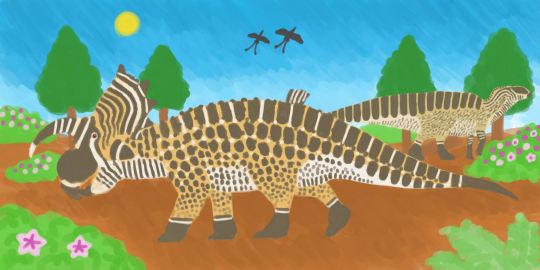

Utahraptors trapped in quicksand, Rapetosaurus and Alamosaurus, Judith River Ceratopsid "Ava", and an aerial battle between Amplibuteo and Teratornis
3 notes
·
View notes
Photo

Everyone watching birds in the rain garden. #dinocember #dinocember2020 #keepinganeyeontheancestors #dinojuncowatch https://www.instagram.com/p/CJd6WDcAUl4/?igshid=1psqgvcrwk3n9
0 notes
Photo

(Note: I am not a professional paleontologist or even biologist. I am just and amateur paleoartist and enthusiast. If my infos are off in some way, feel free to correct them ^^)
-
DINOCEMBER
16 - Oxalaia quilombensis (referencing the african deity Oxalá and the Brazilian quilombo settlements)
- Late Cretaceous (100-93 Ma BCE)
- Alcântara Formation, Maranhão, Brazil
The largest non-avian theropod found in Brazil, Oxalaia is a large spinosauridae that lived in a region of tropical forests cut by rivers and lagoons, dominated by conifers, horsetails and ferns, surrounded by a vast semi-arid region, almost like an oasis in the middle of a merciless desert, where this animal reigned over the others, like a true river dragon in the middle of Cajual Island, where it had been discovered. Formally named in 2011, this theropod was described by Alexander Kellner, Elaine Machado, Sergio Azevedo, Deise Henriques, and Luciana Carvalho, based on the fossil of the tip of its snout, unique enough to be a new species, estimated to be between 12 and 14 meters long and weighing up to 7 tons.
The similarities between Oxalaia and its most famous relative, the Spinosaurus, found in Egypt and Morocco, go beyond its large dimensions and ecological niche, both being considered by some paleontologists as members of the same genus. With such a thought, and even considering Oxalaia as a very close relative and distinct from its African counterpart, the new discoveries related to Spinosaurus could be applied to the Brazilian dinosaur, such as the various adaptations for a semi-aquatic life, as shorter posterior members, nostrils on top of the head, conical teeth for catching slippery prey and, more recently discovered, long neural spines on its tail, similar to that of a newt, which would assist in underwater locomotion. In addition, much of the paleofauna present in the Alcântara Formation is very similar to the Kem Kem and Bahariya formations in North Africa, such as truly gigantic fish, sauropods, pterosaurs, noasauridae and crocodylomorphs, in addition to the famous theropod Carcharodontosaurus, present as a "adversary" of both Oxalaia and Spinosaurus on both continents.
- Color based on three different animals: Cuvier’s dwarf caiman (Paleosuchus palpebrosus), Cryptic Golden Tegu (Tupinambis cryptus) and Paraguayan Caiman Lizard (Dracaena paraguayensis).
#dinocember#dinocember2020#dinosaur#theropod#brazilian dinosaurs#spinosaurus#oxalaia#Oxalaia quilombensis#spinosauridae#saurischia#Cajual#Alcantara Formation#Digital Artists#artists on tumblr#digital art#digital drawing#paleobiology#paleontology#paleoart#paleoillustration#sciart#Science illustration#Brazil
31 notes
·
View notes
Photo

(Note: I am not a professional paleontologist or even biologist. I am just and amateur paleoartist and enthusiast. If my infos are off in some way, feel free to correct them ^^)
-
DINOCEMBER
5 - Pachycephalosaurus wyomingensis (From Greek “Thick-headed lizard”)
- Late Cretaceous (70-66 Ma BCE)
- Hell Creek, East Coat, USA
One of the most iconic North American dinosaurs, the Pachycephalosaurus was a bipedal animal, being the largest member of its group, about 4.5 meters long and weighing 450 kg. Its most striking feature is certainly the bony dome at the top of its skull, about 25 cm thick, probably being used in disputes between males for partners, territory or simply for interaction between members of the species, but probably not in a similar way to current mountain goat, but more like a rhino , pushing each other with the head, or attacking the side of the body, more or less like a giraffe.
Pachycephalosauridae were mostly present in the Northern Hemisphere during the Cretaceous, being among the last groups of non-Avian dinosaurs before the Cretaceous-Paleogene Extinction, 66 Ma ago. Probably the pachycephalosaurus had a good vision, with the orbits facing almost forward in its skull, which would have helped to locate the various predators with which it shared the Hell Creek environment, marked by coniferous and fern forests and flooded plains, at the mercy of tyrannosaurs and raptors. The pachycephalosaurus diet should be mostly herbivorous, but its small, ridged teeth could very well capture insects and even steal eggs from other animals.
Two other species of pachycephalosaurs in Hell Creek, Stygimoloch and Dracorex, are interpreted by many as growth stages of this animal, with Dracorex being an "adolescent" stage, both having less domed skulls and more spines on the sides of the head - in this drawing , Dracorex is the individual stealing an egg, possibly from a thescelosaurus, here taken as a youngling observed by an adult male.
- Color scheme based on an Ocellated Turkey (Meleagris ocellata)
#dinocember#dinocember2020#pachycephalosaurus#dracorex#stygimoloch#marginocephalia#ornithischia#hell creek#saurian#paleobiology#paleontology#paleoart#paleoillustration#dinosaur#creature art#crature concept#creature design#nature#sciart#science illustration#art#Digital Artists#artists on tumblr#digital art#digital drawing#cretaceous#late cretaceous#dinovember
38 notes
·
View notes
Photo
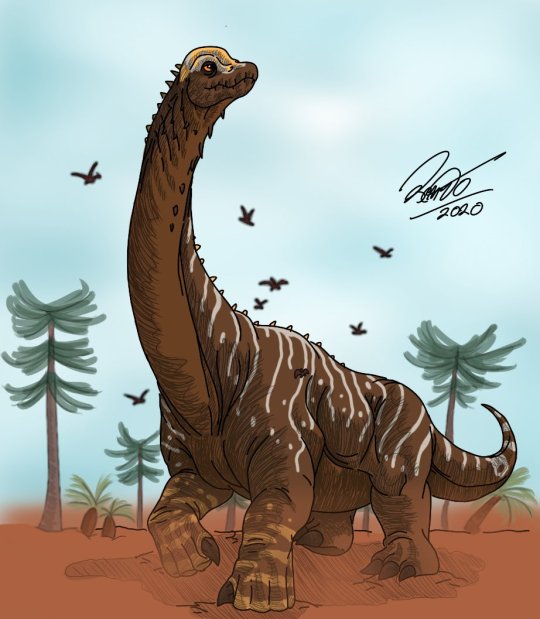
(Note: I am not a professional paleontologist or even biologist. I am just and amateur paleoartist and enthusiast. If my infos are off in some way, feel free to correct them ^^)
-
DINOCEMBER
12 - Giraffatitan brancai (from Greek "titanic giraffe")
- Late Jurassic (150-145 Ma BCE)
- Tendaguru Formation, Lindi, Tanzania
One of the most impressive sauropods that has ever existed, the Giraffatitan is the member of its family with the most complete fossil material, being for a long time considered the largest terrestrial animal that has ever existed, at least 26 meters long, 12 meters high and weighing somewhere between 15 and 60 tonnes, today being smaller than its distant relatives, the titanosaurs, but still impressive nonetheless. Although its name is not familiar to many, the Giraffatitan has long been considered the African species of the Brachiosaurus genus in North America, until recent research has indicated its identity as a species of its own, but still a member of the same family.
As a brachiosauridae, the Giraffatitan had as main characteristics its forelimbs larger than its hindqlimbs, a relatively short tail for a sauropod and a long and at the same time muscular neck, which it would use to reach the highest leaves of trees such as conifers, araucaria and palm trees, being a high-browser, just like the current giraffes, probably walking in small groups through the large savanna of the Tendaguru Formation, next to a large coastal plain, dotted with areas of tropical vegetation and wetlands, but still without plants with flowers or fruits , having as "sister" formations, both in fauna and environment, the Morrison Formation, in the western USA, and the Lourinhã Formation, in Portugal, all showing the great abundance of Jurassic paleofauna.
For a long time, these large sauropods were believed to be aquatic animals, unable to support their massive bodies on land and using their nostrils on top of their heads as a "snorkel", but everything indicates that both the Giraffatitan and other large sauropods were totally able to live on dry land, with relatively light bones and air sac systems to reduce their weight, albeit massive. The position of their nostrils was also revealed to be erroneous, having them closer to the tip of their snouts, which is the rule in most tetrapods.
- Color scheme based on a Nyala (Tragelaphus angasii)
#sauropod#brachiosaurus#giraffatitan#Tendaguru Formation#dinocember#dinocember2020#Saurischia#african dinosaur#paleobiology#paleontology#paleoart#paleoillustration#Science illustration#sciart#creature art#creature design#creature concept#macronarian#brachiosauridae#it's a dinosaur#dinosaur#dinovember#Digital Artists#digital drawing#digital art#artists on tumblr#Jurassic#jurassic park
31 notes
·
View notes
Photo
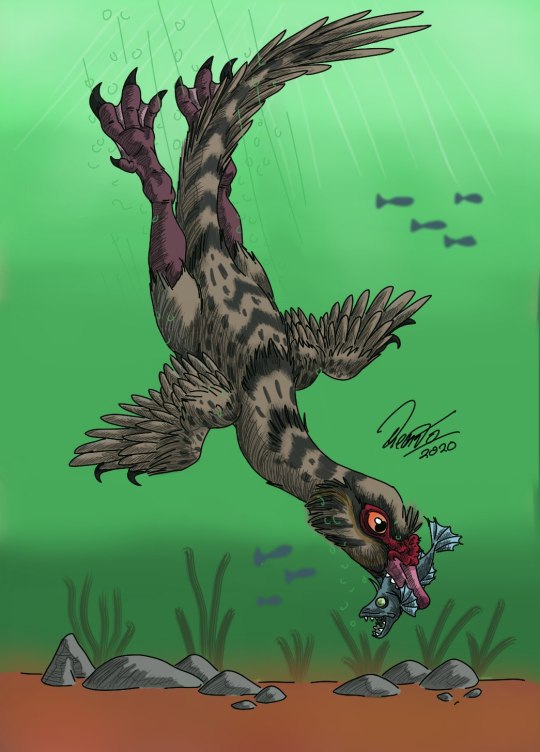
(Note: I am not a professional paleontologist or even biologist. I am just and amateur paleoartist and enthusiast. If my infos are off in some way, feel free to correct them ^^)
-
DINOCEMBER
7 - Halszkaraptor escullei (from Latin "Halszka's hunter" in honor of the Polish paleontologist Halszka Osmólska)
- Late Cretaceous (75-71 Ma BCE)
- Djadochta Formation, Ömnögovi, Mongolia
Formally named in 2017, the Halszkaraptor is one of the great discoveries of the 2010s among non-avian dinosaurs, being the second of these animals with definitive proof of a semi-aquatic lifestyle - the first being the Spinosaurus in 2014. Approximate size of a mallard duck, this little dromaeosaur - or "raptor" - inhabited a region of streams and ponds in the middle of the seasonal semi-arid Djadochta formation, or "Flaming Hills" in the Mongolian language, presenting a series of characteristics that indicate such adaptations , with a center of gravity closer to the front of the body, which facilitates swimming and diving movements, in addition to a very long neck in relation to the size of the body and a more upright posture than that of others in its clade, in addition to from possibly having complex nerve endings in its snout to detect prey, more or less like a platypus.
Cau et al. (2017) suggests that the Halszkaraptor would live similarly to the current mergansers, especially the analogy between the long neck and short body, in addition to the bird's serrated beak compared to the dinosaur's conical teeth, curved backwards to catch the slippery prey. The authors of the discovery also point to a swimming mode more similar to that of penguins than to ducks and grebes, using the short forelimbs as the main form of propulsion.
There is a small error that I noticed only after finishing this drawing: Halszkaraptor's nostrils are located on the front of the beak, not close to the eyes like a duck. Sorry about that .
- Color scheme based on a Fishing Cat (Prionailurus viverrinus) and a Muscovy Duck (Cairina moschata)
#dinocember#dinocember2020#halszkaraptor#duck boy#ducktales woo hoo#dinosaur#raptor#dromaeosaur#theropod#paleobiology#paleoart#paleoillustration#paleontology#sciart#science illustration#nature#digital art#digital drawing#artists on tumblr#Digital Artists#creature art#creature design#creature concept#dinovember#cretaceous#late cretaceous#mongolia#djadochta formation#flaming cliffs#birb
25 notes
·
View notes
Photo

(Note: I am not a professional paleontologist or even biologist. I am just and amateur paleoartist and enthusiast. If my infos are off in some way, feel free to correct them ^^)
-
DINOCEMBER
17 - Buriolestes schultzi (from Greek "Buriol's robber")
18 - Staurikosaurus pricei (from Greek "Southern Cross lizard")
- Late Triassic (233 Ma BCE)
- Santa Maria Formation, Rio Grande do Sul
One of the great discoveries of 2016, the Buriolestes is a sauropodomorph, the lineage of non-avian dinosaurs characterized by their relatively rounded bodies, front legs with clawed first fingers and relatively long tails and necks, which over millions of years would be slowly replaced by the immense sauropods as the main herbivores in various environments around the world. However, unlike the most famous Plateosaurus and Musaurus, Buriolestes had sharp, serrated teeth, better adapted to a carnivorous and possibly omnivorous diet, unlike the leaf-shaped teeth of their herbivorous relatives. Such a characteristic would indicate that, initially on their evolutionary path, the Saurischians and probably the dinosaurs as a whole were all carnivores, gradually replacing the other animals that dominated several niches until the End-Triassic mass extinction circa 201 Ma BCE, after which the dinosaurs became the lords of the world.
Amidst the sparse dry forests cut by rivers of the Santa Maria Formation, the Buriolestes would probably come into direct confrontation with the Staurikosaurus, a medium-sized herrerasauridae, about 2 meters long and 80 kg, being the first dinosaur described in Brazilian territory by American Edwin Harris Colbert, at the service of the American Museum of Natural History, where the fossil remains to this day. Competing with its most massive relative, the Gnathovorax, and the immense rauisuchian Prestosuchus, Staurikosaurus, like other herrerasauridae, was an active and opportunistic predator, feeding mainly on small animals, such as rhynchosaurs, lagerpetids and proto-mammals. The relationship between herrerasauridae and other dinosaurs is still nebulous, classically considered as distant cousins of the theropods or, in a more recent classification, as a sister group of sauropodomorphs within Saurischia, with theropods and ornithischians together in a separate group, called Ornithoscelida (Baron et al, 2017).
- Color schemes based on a Bush Dog (Speothos venaticus) for the Buriolestes and a Maned Wolf (Chrysocyon brachyurus) and Jaguarundi (Herpailurus yagouaroundi) for the Staurikosaurus. Pose inspired by the famous “Leaping Laelaps” by Charles R Knight.
#dinocember#dinocember2020#dinosaur#brazilian dinosaurs#sauropodomorpha#basal dinosaur#Buriolestes#Staurikosaurus#Triassic#Herrerasauridae#Digital Artists#artists on tumblr#paleobiology#paleontology#paleoart#paleoillustration#sciart#Science illustration#creature art#creature design#creature concept#digital art#digital drawing#StaurikosaurusbelongstoBR#Brazil
11 notes
·
View notes
Photo

(Note: I am not a professional paleontologist or even biologist. I am just and amateur paleoartist and enthusiast. If my infos are off in some way, feel free to correct them ^^)
-
DINOCEMBER
11 - Ubirajara jubatus (from Tupi “lord of the spears”)
- Early Cretaceous (110 Ma BCE)
- Crato Formation, Ceará, Brazil
Named at the end of 2020, Ubirajara is one of the most impressive fossils found in Brazilian territory, being a member of the Compsognathidae, small theropods covered with proto-feathers - or "dino-fuzz" - related to raptors and tyrannosaurs, whose most famous members are China's Sinosauropteryx and Germany's Compsognathus itself. Described from a partial skeleton without the skull, Ubirajara presents impressions of its fuzz, having an apparent "mane" in its dorsal region and pairs of quills on its shoulders, similar to what is found in the current birds-of-paradise, probably used in courtship or to intimidate rivals.
The Crato Formation, as well as most of the formations in the Araripe Basin, would be the margins of a large saltwater lagoon, as well as a system of rivers surrounded by gymnosperms and some of the first flowering plants, being rich in fossil extract, especially of pterosaurs, and some curious animals, like the Enantiornithe Cratoavis. Unfortunately, Ubirajara, like other Brazilian fossils, is a target of international fossil trafficking, not having a single native author in the paper that describes it, with the team led by David Martill, a German paleontologist who smugled the Ubirajara fossil to Germany in 1995, and he cannot set foot on Brazilian territory for this and other crimes. Since its description, Ubirajara has been the target of campaigns for its repatriation, as well as other national fossils. I use this drawing as my collaboration for the campaign, and that so that this colonialist and criminal mentality ceases to exist in the paleontological community.
- Ubirajara’s color scheme inspired by a Vinaceous-breasted Amazon (Amazona vinacea) and a Vulturine Parrot (Pyrilia vulturina) and Cratoavis’ colors isnpired by a Black-thorated trogon (Trogon rufus). All of them are Brazilian birds
#UbirajaraBelongstoBR#ubirajara jubatus#ubirajara#theropod#compsognathus#compsognathidae#coelurosauria#feathered dinosaurs#Brazil#brazilian dinosaurs#dinocember2020#dinovember#Cratoavis#Crato Formation#Araripe Basin#creature design#creature art#creature concept#dinosaur#paleobiology#paleontology#paleoart#paleoillustration#sciart#science illustration
7 notes
·
View notes
Photo

(Note: I am not a professional paleontologist or even biologist. I am just and amateur paleoartist and enthusiast. If my infos are off in some way, feel free to correct them ^^)
-
DINOCEMBER
14 (Front) - Santanaraptor placidus (from the Latin "Thief of Santana")
15 (Back) - Aratasaurus museunacionali (combination of Tupi "ara" and "atá" and Greek "sauros" as "lizard born from fire")
- Early Cretaceous (112-108 Ma BCE)
- Romulado Formation, Ceara, Brazil
Probably one of the most famous Brazilian dinosaurs, the Santanaraptor is a member of the tyrannosauroid family, presenting more basal characteristics similar to the Asian Guanlong and Dilong, with long legs adapted for running, a trait common to most theropods of this lineage at the beginning of their walk to become massive predators, in the future using their powerful skulls and jaws as their main hunting weapon. The original Santanaraptor fossil, formally named in 1996, mainly featured the animal's back and legs, as well as soft tissue prints, such as muscle fibers and parts of the epidermis, with an estimated size for an adult individual at just under 2 meters, close the size of a velociraptor.
Also present on the great coastal plain at the same time as the Santanaraptor, the Aratasaurus was formally named in 2020, with its specific name honoring the National Museum of Brazil, unfortunately destroyed by the flames in 2018 resulting from years of neglect. The classification of Aratasaurus is still unclear, but it seems that it would also be a Coelurosaur, as well as Santanaraptor, part of the lineage that include birds and the most famous theropods, such as dromaeosaurs, tyrannosaurs and ornithomimosaurs. Aratasaurus seems to be more robust than Santanaraptor, about 3 meters long. I imagine that the two species would encouter themselves in life, like Aratasaurus perhaps acting similarly to a large spotted hyena while the agile Santanaraptor would be something like a coati or a mongoose, more of a opportunistic hunter.
- Color schemes based on a Northern Ground Hornbill (Bucorvus abyssinicus) for the Aratasaurus and a Madagascan Serpent Eagle (Eutriorchis astur) for the Santanaraptor.
#Araripe Basin#Romulado Formation#Brazil#dinocember#dinocember2020#santanaraptor#aratasaurus#aratasaurus museunacionali#Coelurosauria#brazilian dinosaurs#theropod#Tyrannosauroidea#saurischia#paleobiology#paleontology#paleoart#paleoillustration#Science illustration#sciart#cretaceous#south america#raptor#creature art#creature design#creature concept#Digital Artists#digital drawing#digital art#artists on tumblr
6 notes
·
View notes
Photo

(Note: I am not a professional paleontologist or even biologist. I am just and amateur paleoartist and enthusiast. If my infos are off in some way, feel free to correct them ^^)
-
DINOCEMBER
20 - Tyrannosaurus rex (from greek/latin "Tyrant lizard king")
- Late Cretaceous (68-66 Ma BCE)
- Hell Creek Formation, Western USA
A famous creature like the Tyrannosaurus needs no introduction, represented to exhaustion in so many different forms of media but still always with something new to be discovered about him, being certainly the theropod, and perhaps even the most studied prehistoric animal since its discovery by Osborn and Brown in 1905. At the top of the food chain in the Hell Creek formation, dominated by forests, swamps, coastal plains and fern prairies, this massive theropod used its powerful jaws as its main weapon, being able to crush bones relatively easily, imposing between 35 and 50 thousand Newtons of force with its teeth. A Tyrannosaurus started its life as an agile predator, with slender jaws and long legs perfect for running, becoming a 13 meters long, almost 5 meters high and up to 8 ton colossus when reaching adulthood, slower but not less efficient.
The presence of feathers in T. rex has been questioned in recent years due to skin impressions from different areas of its body, showing small scales similar to the reticula of the legs of some birds, giving an almost leathery appearance to the animal's skin. As feathers are a basal and common characteristic of several coelurosaurs, where tyrannosaurs are included, it is believed that its young could be covered by plumage and lose a good part of it when they mature, similar to an elephant, which is more hairy when it's born, but still has sparse coat as an adult. Another recent discovery about the king of dinosaurs, applied to many others as well, is the fact that they do not roar, as they would not have specialized organs for this in their throats, communicating through deep bellows, similarly to crocodiles and certain birds like bitterns and emus.
- Color scheme based on Fang from Genndy Tartakovsky’s Primal and losely on the Argentine Black and White Tegu (Salvator merianae) patterns.
-
Dinocember is finished ^^ Creatuanary is next. Happy 2021 everyone !
#dinocember#dinocember2020#tyrannosaurus#tyrannosauridae#Tyrannosaurus rex#Primal#Fang#Hell Creek#theropod#Coelurosauria#isn't she beautiful#paleobiology#paleoart#paleontology#paleoillustration#cretaceous#late cretaceous#Science illustration#sciart#nature#Digital Artists#artists on tumblr#digital art#digital drawing
5 notes
·
View notes
Photo
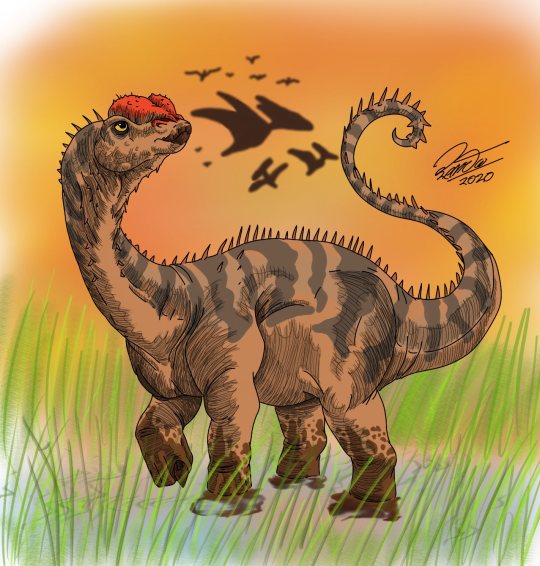
(Note: I am not a professional paleontologist or even biologist. I am just and amateur paleoartist and enthusiast. If my infos are off in some way, feel free to correct them ^^)
-
DINOCEMBER
4 - Amazonsaurus maranhensis (combination from the Greek "sauros" - lizard - and Amazon)
- Early Cretaceous (125-100 Ma BCE)
- Itapecuru Formation, Maranhão, Brazil
Discovered in the early 2000s, the Amazonsaurus stands out among other brazilian sauropods, non-avian dinosaurs with long necks and among the largest terrestrial animals that have ever lived, because it is one of the few that does not belong to the clade Titanosauria, being closer to the famous Diplodocus, from Jurassic in North America. A large animal, but relatively small for its order, the Amazonsaurus measured just over 12 meters in length and weighed about 5 tons, which lived in a flooded region next to a river delta, feeding on several plants that existed there.
The Amazonsaurus belongs to the Rebbachisauridae family, belonging to the Diplodocimorpha, but very different from the classic image of these animals, with very long necks and tails in barrel-shaped bodies, having comparatively shorter necks, but not so much to the Dicraeosauridae, being some members of the more specialized family to graze and feed on lower plants, as in the case of the Nigersaurus, a relative of the Amazonsaurus of the Elrhaz formation, in Niger. The Rebbachisauridae and other Diplodocimorpha already became more and more rare in the beginning of the Cretaceous, being totally replaced by the immense titanosaurs in their ecological niche, being thus until the Cretaceous-Paleogene extinction.
- Color scheme inspired by an African Forest Bufallo (Syncerus cafer nanus) and a Blue-Tongued Skink (genus Tiliqua)
#Digital Artists#artists on tumblr#dinocember#dinocember2020#sauropod#amazonsaurus#rebbachisauridae#diplodocus#Brazil#dinosaur#Brasil#saurischia#sauropodomorpha#creature design#creature art#nature#paleoart#paleoillustration#paleontology#sciart#science illustration#digital drawing#digital art#art#cretaceous#early cretaceous#dinovember
6 notes
·
View notes
Photo

(Note: I am not a professional paleontologist or even biologist. I am just and amateur paleoartist and enthusiast. If my infos are off in some way, feel free to correct them ^^)
-
DINOCEMBER
9 - Argentavis magnificens (from Latin "Argentine magnificent bird" or literally "magnificent silver bird")
- Late Miocene (9-6.8 Ma BCE)
- Cerro Azul Formation, La Pampa, Argentina
One of the many curious animals of prehistoric South America, Argentavis was for a long time the largest flying avian dinosaur ever, with an estimated wingspan of 5 to 6 meters from one end to the other of its wings - according to most recent estimates; until then there was talk of absurd 7 to 8 meters in wingspan - and estimated weight between 25 and 40 kg, which would allow it to fly using air currents, similarly to the current vultures. For a long time, this animal and other dinosaurs of its family, the Teratornithidae, were interpreted as immense carrion birds, with a lifestyle similar to that of a condor, which would feed on carcasses of large mammals until they were extinct at the end of the Pleistocene, about 11,000 years ago.
Currently, it is believed that teratornithids, being robust and extremely powerful birds, would not be well equipped to be primarily carrion eaters, having skulls more similar to birds of prey, possibly being active predators, but not at the level of eagles and hawks, since their claws were not curved to the point of being efficient in catching prey in mid-flight. Paleontologist Mark Witton, in a fantastic post on his blog, suggests, based on the work of several experts, that these dinosaurs would be "ground-stalkers", sort of like a seriema or a caracara, catching small animals with their paws or stepping on them and then swallow them whole - the skull of Teratornis merriami, from North America, has enough flexibility for that, which may be possible for Argentavis too.
Once again, such developments show how paleontology and science in general are always changing, open to new discoveries in order to learn more about the world before ours.
- Color scehem based on a Palm-nut Vulture (Gypohierax angolensis) and an Ornate Hawk-eagle Spizaetus ornatus)
#Digital Artists#artists on tumblr#argentavis#dinocember2020#dinovember#teratorn#bird of prey#teratornithidae#cathartidae#vulture#argentina#south america#Miocene#avian dinosaur#dinosaur#creature design#creature art#creature concept#paleobiology#paleontology#paleoart#paleoillustration#sciart#science illustration#hachure#digital art#digital drawing#dinocember
4 notes
·
View notes
Photo
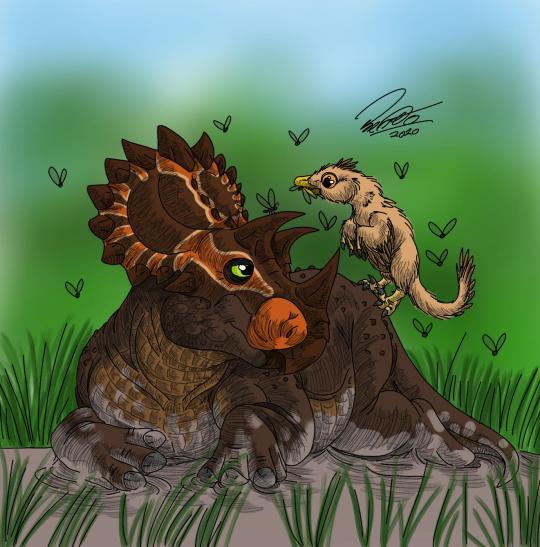
(Note: I am not a professional paleontologist or even biologist. I am just and amateur paleoartist and enthusiast. If my infos are off in some way, feel free to correct them ^^)
-
DINOCEMBER
8 - Regaliceratops peterhewsi (from Latin "Royal horned face")
- Late Cretaceous (68 Ma BCE)
- St. Mary River Formation, Alberta, Canada
Named in 2015, the Regaliceratops is one of many ceratopsids, one of the most recognized groups of dinosaurs due to their large heads adorned with bone frills and horn sets, found in North America, native to the ancient continent of Laramidia, in the western portion of the Western Interior Seaway. Its name comes from the set of bony scutes at the top of its frill, looking kinda like a tiara, being nicknamed by the team that found hit as "Hellboy", both for the relatively short horns at the top of its orbits and due to the difficulty of removing the fossil. from the matrix. This animal, of a size close to that of an Indian rhinoceros, lived in a region of seasonal floodplains and swamps, along with other ceratopsians, nodosaurs, hadrosaurs and raptors, most likely suffering from the tyrannosaur Albertosaurus, native to the same region and geological time.
The Regaliceratops belonged to the Chasmosaurinae family, one of the two large groups of ceratopsians native to North America during the Late Cretaceous, being a close relative of the famous Triceratops of the Hell Creek Formation. Chasmosaurines were characterized by relatively large bone frills, resulting in some of the largest skulls in the animal kingdom, such as the Torosaurus and Pentaceratops, and more prominent brow horns, with small nasal horns. Mostly burly herbivores, these animals would occupy a niche similar to that of large antelopes, deer and cattle in their habitats, using their scissor beaks to uproot shrubs and ferns from the ground, in addition to possibly spending time in mud puddles, like rhinos and buffaloes do today, to scare away insects and other skin parasites, as I decided to represent here. A flock of flies from a large animal such as Regaliceratops would certainly attract small animals in search of a meal, such as a fluff-covered Saurornitholestes chick, which this old female decided to accept.
- Color scheme (escept for the frill) based on a moose (Alces alces)
#dinocember#dinocember2020#regaliceratops#ceratopsian#ceratopsid#ornithischia#chasmosaurinae#alberta#dinosaur#dinossauro#late cretaceous#laramidia#sciart#science illustration#paleobiology#paleontology#hachure#digital art#digital drawing#Digital Artists#artists on tumblr#creature#creature art#creature design#creature concept#floof#saurornitholestes#cretaceous#dinovember
5 notes
·
View notes
Photo
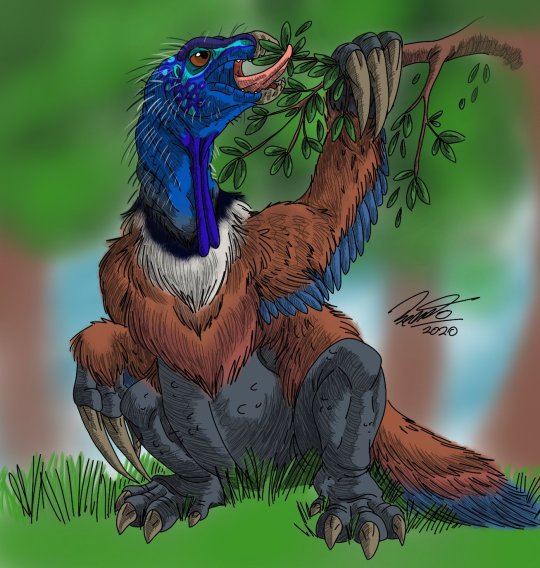
(Note: I am not a professional paleontologist or even biologist. I am just and amateur paleoartist and enthusiast. If my infos are off in some way, feel free to correct them ^^)
-
DINOCEMBER
6 - Therizinosaurus cheloniformis (from Greek "scythe lizard")
- Late Cretaceous (70 Ma BCE)
- Nemegt Formation, Gobi Desert, Mongolia
The largest and probably the last member of his family, the Therizinosaurus was, strangely, a theropod belonging to the Maniraptora, close to both the famous raptors and the birds, although he looks nothing like them. Probably a high-browsing herbivore, this non-avian dinosaur had a series of adaptations for a lifestyle similar to that of a giant sloth, a mammal that would exist millions of years later, having a long neck, more robust hind legs , finished in four toes that touched the ground - unlike the three toes for other theropods -, a horny beak to strip leaves from trees, a large belly to process its food - more or less similar to what occurs in today's gorillas - and the largest claws of any terrestrial animal, measuring about 50 cm, probably used in their feeding and also to defend themselves.
The Therizinosaurus' lineage had its fossils found in both North America and Asia, and for some time a member of its family - Beipiaosaurus, from China - was the largest non-Avian dinosaur with confirmed presence of feathers on its body due fossil impressions, confirming their position among the Maniraptora, almost all of them with feathery bodies. However, the large size of this animal, between 9 and 10 meters in length and weighing up to 3 tons, and the Nemegt Formation's environment, characterized by areas of subtropical woodlands cut by several rivers and surrounded by a semi-arid environment - almost like an oasis - would make the massive presence of feathers something not very advantageous for this animal, and they may be more vestigial structures, such as the hair of an elephant, even shorter and less showy, like the fur of a kangaroo or a horse.
- Color scheme somewhat based on an Emu (Dromaius novaehollandiae) and a Hoffman’s two-toed sloth (Choloepus hoffmanni)
#dinocember#dinocember2020#therizinosaurus#therizinosaur#theropod#maniraptora#therizinosauria#Nemegt formation#mongolia#Gobi#Bird#dinosaur#paleobiology#paleoart#paleoillustration#paleontology#sciart#science illustration#nature#digital art#digital drawing#Digital Artists#artists on tumblr#cretaceous#late cretaceous#creature art#creature design#creature concept#dinovember
3 notes
·
View notes
Text
A Portrait of the Cold-Crested Lizard

I made it just because December's here
1 note
·
View note